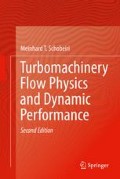Abstract
The following chapters deal with the nonlinear transient simulation of turbomachinery systems. Power generation steam and gas turbine engines, combined cycle systems, aero gas turbine engines ranging from single spool engines to multi-spool high pressure core engines with an afterburner for supersonic flights, rocket propulsion systems and compression systems for transport of natural gas with a network of pipeline systems are a few examples of systems that heavily involve turbomachinery components.
Considering a power generation gas turbine engine as a turbomachinery system that is designed for steady state operation, its behavior during routine startups, shot downs, and operational load changes significantly deviates from the steady state design point. Aero gas turbine engines have to cover a relatively broad operational envelope that includes takeoff, low and high altitude operation conditions, as well as landing. During these operations, the components are in a continuous dynamic interaction with each other, where the aero-thermodynamic as well as the mechanical load conditions undergo temporal changes. As an example, the acceleration/ deceleration process causes a dynamic mismatch between the turbine and compressor power resulting in temporal change of the shaft speed.
In the above cases, the turbomachinery systems are subjected to the operating modes that are specific to the system operation. Besides these foreseeable events, there are unforeseeable operation scenarios that are not accounted for when designing the system. System failures, such as, blade loss during a routine operation, loss of cooling mass flow through the cooled turbine blades, adverse operation conditions that force the compressor component to surge, and failure of the control system, are a few examples of adverse operational conditions. In all of these operations, the system experiences adverse changes in total fluid and the thermodynamic process leading to greater aerodynamic, thermal and mechanical stress conditions.
The trend in the development of gas turbine technology during the past decades shows a continuous increase in efficiency, performance, and specific load capacities. This trend is inherently associated with increased aerodynamic, thermal, and mechanical stresses. Under this circumstance, each component operates in the vicinity of its aerodynamic, thermal and mechanical stress limits. Adverse operational conditions that cause a component to operate beyond its limits can cause structural damages as a result of increased aerodynamic, thermal, and structural stresses. To prevent this, the total response of the system, including aerodynamic, thermal, and mechanical responses must be known in the stage of design and development of new turbomachinery systems.
This chapter describes the physical basis for the non-linear dynamic simulation of gas turbine components and systems. A brief explanation of the numerical method for solution is followed by detailed dynamic simulation of several components described in the following chapters.
Access this chapter
Tax calculation will be finalised at checkout
Purchases are for personal use only
Preview
Unable to display preview. Download preview PDF.
References
Schobeiri, M.T.: Aero-Thermodynamics of Unsteady Flows in Gas Turbine Systems. Brown Boveri Company, Gas Turbine Division Baden Switzerland, BBC-TCG-51 (1985)
Schobeiri, T.: COTRAN, the Computer Code for Simulation of Unsteady Behavior of Gas Turbines. Brown Boveri Company, Gas Turbine Division Baden Switzerland, BBC-TCG-53 (1985b)
Schobeiri, T.: A General Computational Method for Simulation and Prediction of Transient Behavior of Gas Turbines. ASME-86-GT-180 (1986)
Schobeiri, M.T., Abouelkheir, M., Lippke, C.: GETRAN: A Generic, Modularly Structured Computer Code for Simulation of Dynamic Behavior of Aero-and Power Generation Gas Turbine Engines; an honor paper. ASME Transactions, Journal of Gas Turbine and Power 1, 483–494 (1994)
Bird, R.B., Stewart, W.E., Lightfoot, E.N.: Transport Phenomena. John Wiley and Sons, Chichester (1960)
Liniger, W., Willoughby, R.: Efficient integration methods for stiff systems of ordinary differential equations. SIAM. Numerical Analysis 7(1) (1970)
Author information
Authors and Affiliations
Corresponding author
Rights and permissions
Copyright information
© 2012 Springer-Verlag Berlin Heidelberg
About this chapter
Cite this chapter
Schobeiri, M.T. (2012). Nonlinear Dynamic Simulation of Turbomachinery Components and Systems. In: Turbomachinery Flow Physics and Dynamic Performance. Springer, Berlin, Heidelberg. https://doi.org/10.1007/978-3-642-24675-3_12
Download citation
DOI: https://doi.org/10.1007/978-3-642-24675-3_12
Published:
Publisher Name: Springer, Berlin, Heidelberg
Print ISBN: 978-3-642-24674-6
Online ISBN: 978-3-642-24675-3
eBook Packages: EngineeringEngineering (R0)

